Horticulturists Love To Grow Comfrey – It’s A Garden ‘Cult Classic’ With Many Uses

PERENNIALS > COMFREY
Reviewed By DAN ORI

Dan has over 27 years’ under his belt caring for plants and gardens. Working as a Horticultural Instructor and Consultant, he draws on a diverse range of experience that includes working as a Head Gardener, Tree Surgeon, Garden Centre Trouble Shooter, and writer of academic papers. Dan has a Level 3 Diploma in Horticulture and is currently a candidate for the RHS’s most prestigious award – The Master of Horticulture.
Contributions From DAVE GOULSON

Dave Goulson is the Professor of Biology at the University of Sussex and a specialist in the Ecology & Conservation of bees and other insects. He founded the charity the Bumblebee Conservation Trust in 2016 - which now has over 12,000 members - and he is the Director of The Buzz Club. Dave has published more than 300 scientific articles and several books on ecology and insect conservation, including Gardening For Bumblebees.
IN THIS GUIDE
Plain and humble, yet bursting with goodness and vitality – that’s comfrey in a nutshell.
Though the small flowers possess their own rustic charm, this plant’s virtues are wholly practical.
It is renowned for improving soil health, and its nutrient-rich foliage provides raw material for high-quality compost and fertiliser.1Howard, M. M., Plotkin, A., McClure, A., Klepac-Ceraj, V., Griffith, A. B., Brabander, D. J., & Jones, K. L. (2018). Comfrey Mulch Enriches Soil, But Does Not Improve an Indicator Crop within One Season. International Journal of Plant and Soil Science, 22(2), 1–9. https://doi.org/10.9734/ijpss/2018/40403
Overview
| Botanical Name | Symphytum officinale |
| Common Name(s) | Comfrey, Boneset, Knit bone |
| Plant Type | Perennial / Herb |
| Native Area | Europe, Asia, North America |
| Hardiness Rating | H7 |
| Foliage | Deiciduous |
| Flowers | Generally purple, pink, blue or cream-coloured |
| When To Sow | March, April, May, September, October, November |
| Flowering Months | June, July, August |
| When To Prune | June, August, September |
Sunlight
Preferred
Full Sun or Partial Shade
Exposure
Exposed or Sheltered
Size
Height
1 – 1.5M
Spread
1 – 1.5M
Bloom Time
June – August
Soil
Preferred
Most soil types
Moisture
Moist but well drained
pH
Any
Comfrey, native to the UK and Europe, is one of the more humble and unsung members of the Plant Kingdom.2Common comfrey. (n.d.). The Wildlife Trusts. Retrieved March 14, 2023, from https://www.wildlifetrusts.org/wildlife-explorer/wildflowers/common-comfrey
“It is not entirely clear whether it’s native to the UK or not, but comfrey is still a brilliant plant for bees and other pollinators,” shares Dave Goulson, an expert on all things bees.
Not by any stretch a glamour plant that you will find in a stylish flower garden, comfrey is the floral equivalent of a cult classic movie.
Thus – though it is indeed relatively unsung and even humble – this deciduous perennial has its own limited but very devoted following among wise, ‘back to nature’ gardeners.

For the most part, comfrey’s cult status is not because of its ornamental oomph but because of its lengthy list of practical uses.3Comfrey: Its History, Uses & Benefits. (n.d.). Permaculture. Retrieved March 14, 2023, from https://www.permaculture.co.uk/articles/comfrey-its-history-uses-benefits/
Apart from foliage and the flowers, comfrey is one of those rare plants whose underground parts merit a few words.
It has rhizomatous fleshy roots, the upper parts of which resemble tuberous vegetables or root vegetables.

Among these is a long taproot that penetrates very deeply so as to ‘tap’ potassium, calcium and other mineral elements from deep down, bringing these up to the foliage (which is the reason that comfrey leaves are rich in minerals and chemical compounds).4Stallings, B. (2014, March 17). Does Comfrey Really Improve Soil? The Permaculture Research Institute. Retrieved March 14, 2023, from https://www.permaculturenews.org/2014/03/18/comfrey-really-improve-soil/
In addition, the mature plant’s root system is well-formed and extensive.
Here are some pictures of comfrey growing in my garden:
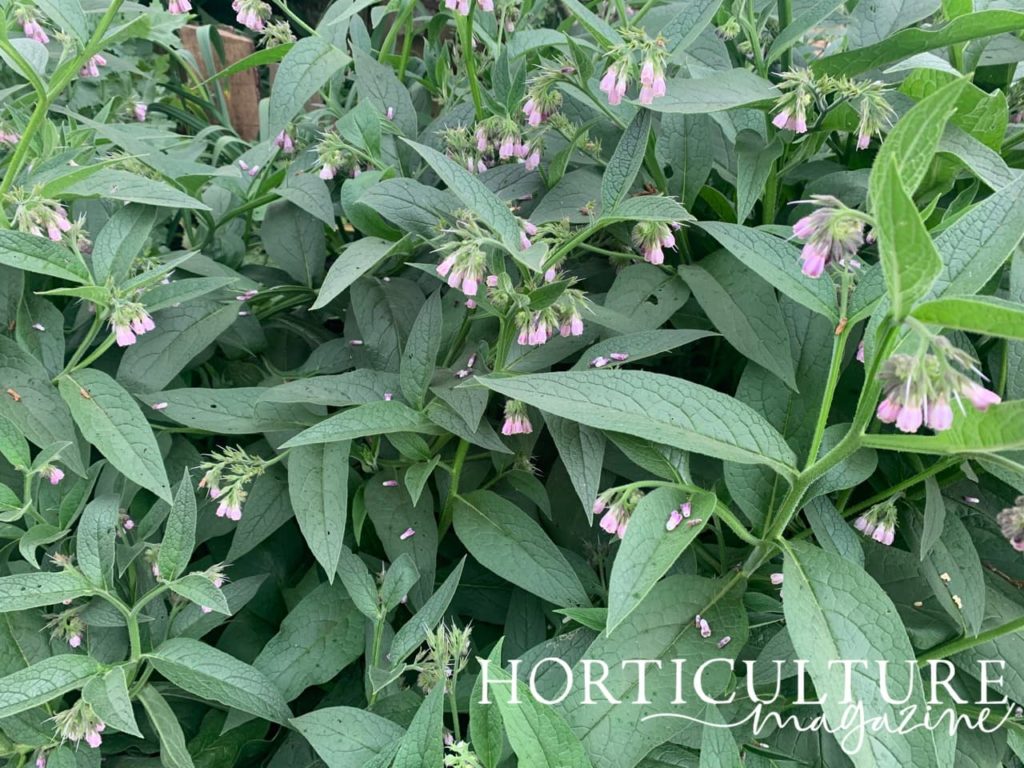
You can see the plant is in flower during the early summer months, in late June.
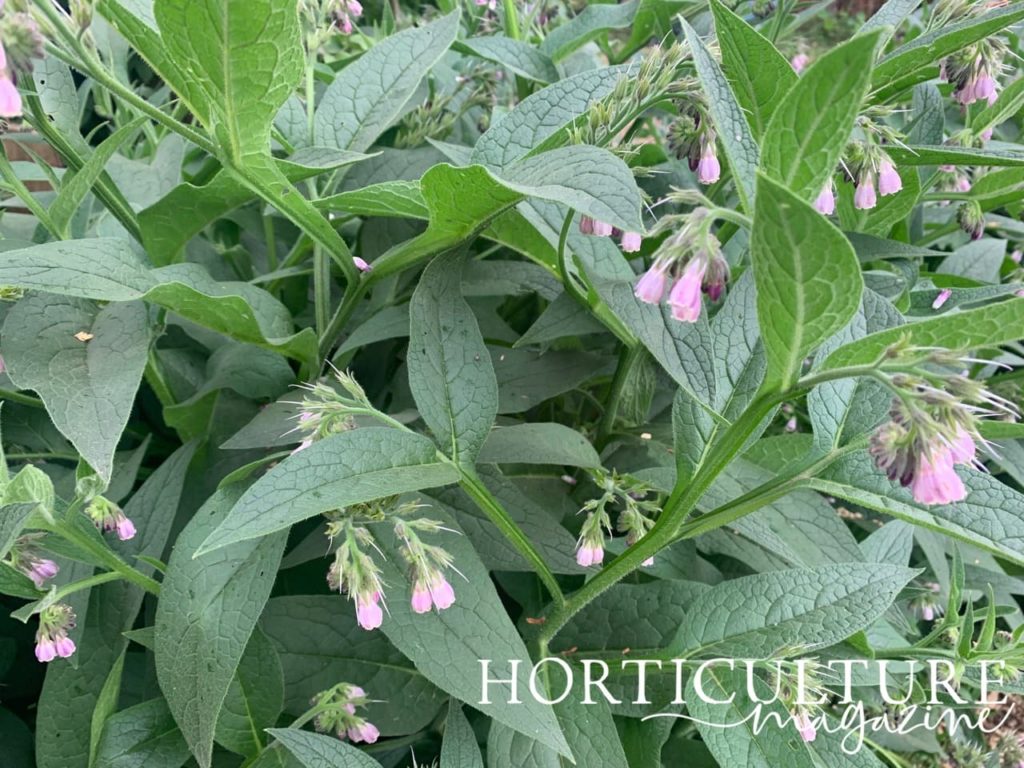
Habitat & Growing Conditions
Symphytum species are found throughout Eurasia, from the United Kingdom and Spain east up to West Siberia in the north and Iran to the south.5Symphytum officinale. (n.d.). Kew Royal Botanic Gardens. Retrieved March 14, 2023, from https://powo.science.kew.org/taxon/urn:lsid:ipni.org:names:120815-1
Moist ground, especially along riverbanks and waterways, is this genus’s preferred habitat.
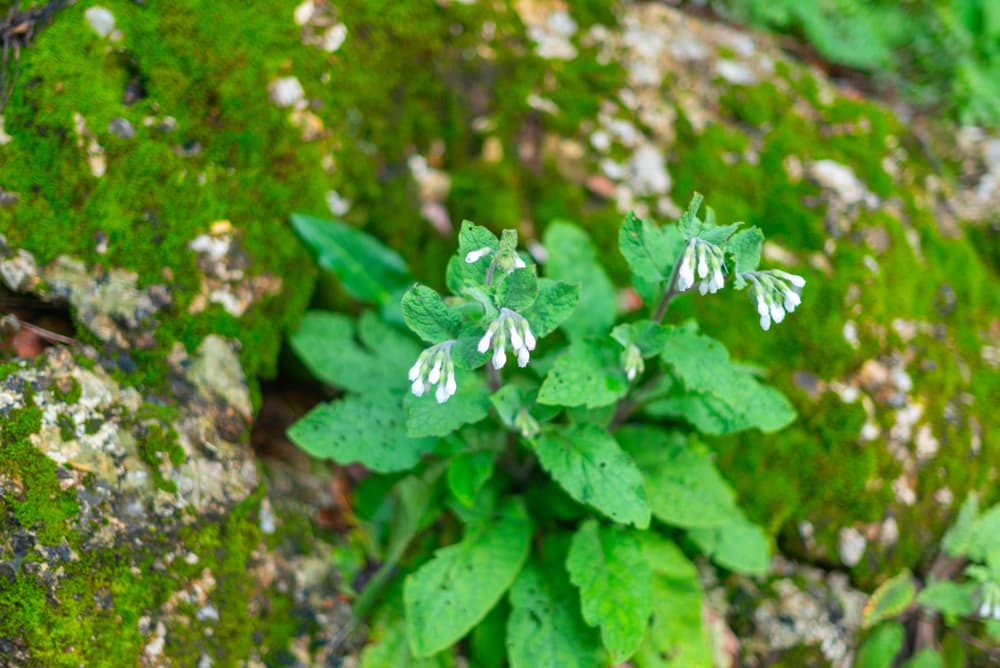
It is also found in the grasslands and steppes of the Caucasus.
A soil pH of slightly acidic to neutral, i.e. 6.1-7.3, is considered to be ideal for Symphytums though this tough plant will do well in any soil pH from about 5.1-8.4, which is a very wide range.
A fully hardy plant, almost all species are hardy down to H7.
How To Grow Comfrey
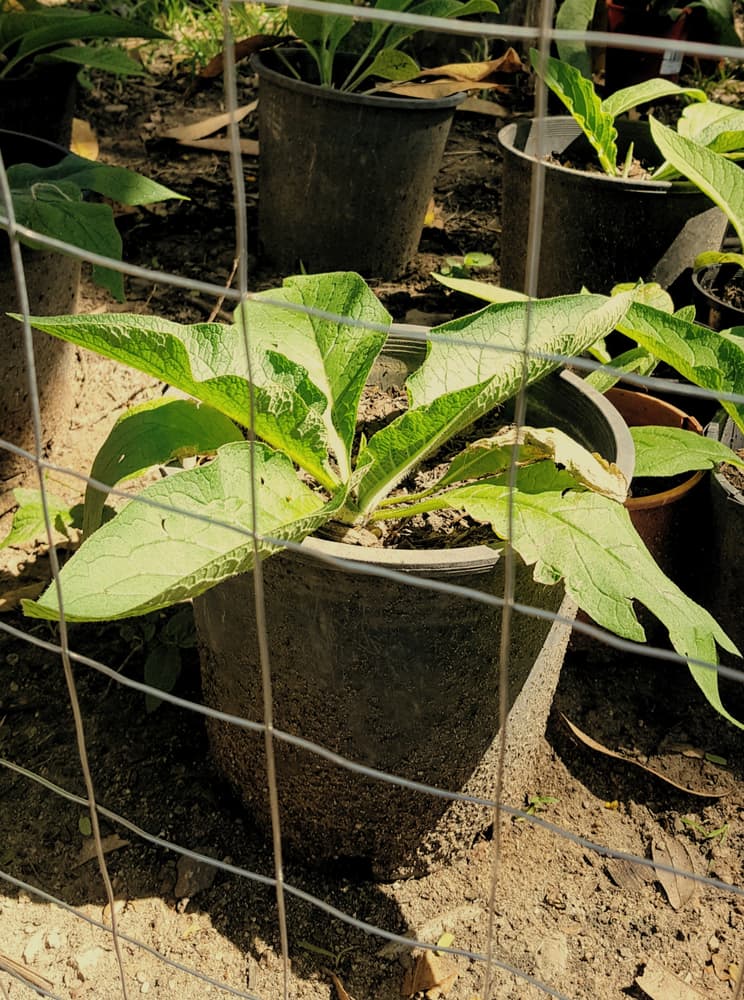
Ordinary this plant might be but some or another variety will be found at your neighbourhood nursery.
The larger garden centres stock most of the commonly grown varieties.
Numerous comfrey varieties are available online.
In any event, if a friend or relative has comfrey, you don’t need to buy it.
Simply get a 15cm root cutting and you’ll have a new comfrey plant!
Planting Comfrey
Comfrey self-selects itself for cottage gardens, wildflower gardens, and kitchen gardens by virtue of its unglamourous but appealing appearance, combined with its beneficial value.
Estate gardens and courtyard gardens? Probably not!
While the sterile and non-spreading varieties can be grown in open ground, it may be wise to grow the self-seeding and rapidly-spreading species in large containers.

Care & Growing Tips
You really don’t need to ‘grow’ comfrey – this vigorous plant will grow by itself.
Indeed, occasionally some species become invasive and hard to eradicate.
Soil Requirements

A rich, fertile loam, which may be a balanced mix of sand, chalk, clay and organic manure, is ideal for comfrey.
Good drainage is preferable but comfrey is one of those plants that can live with poorly-drained soils.
They prefer consistently moist – though not waterlogged – soil.
The species prefer part shade or dappled sunlight whereas some cultivars do best in full sun.
Pruning
Avoid pruning/harvesting the leaves for the first year so that the plant’s root system can develop and get established.
You can harvest the foliage after the plant has reached half its maximum height.
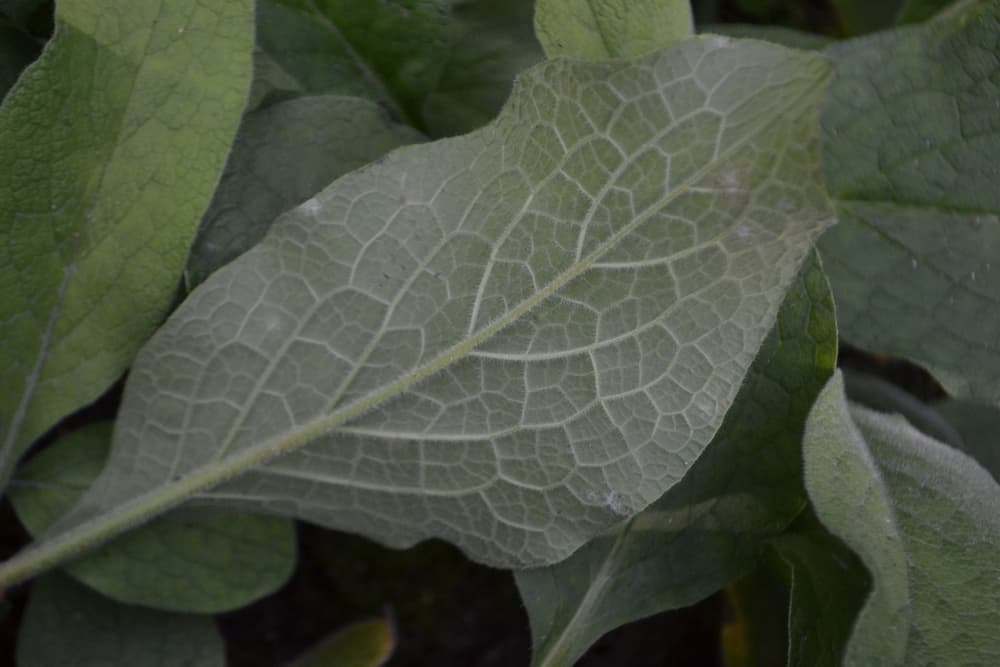
Do so by grasping a handful of leaves and cutting them 8-10cm off the ground using a sharp knife or largeish pruning shears.
If you like comfrey flowers, cut back the stems after flowering is done and you may get a rebloom.
Common Problems
Comfrey is a remarkably disease-free plant.
Slugs and snails may attack it and occasionally it can succumb to powdery mildew but that’s about it in the UK.
Background & Origins
Symphytum officinale or common comfrey has become naturalised in the plains states of the United Kingdom and in a few regions of South America.
Plants of this species were likely carried by the earliest British, Spanish, and other European migrants to the New World.

Symphytum genus comfreys are not to be confused with wild comfrey.
‘Wild comfrey’ is, in fact, the common name of Cynoglossum virginianum, a plant that is native to the United States.6Cynoglossum virginianum. (n.d.). The University of Texas at Austin. Retrieved March 14, 2023, from https://www.wildflower.org/plants/result.php?id_plant=cyvi
It is related to Symphytum comfreys as it too is a member of the Borage Family.
References
- 1Howard, M. M., Plotkin, A., McClure, A., Klepac-Ceraj, V., Griffith, A. B., Brabander, D. J., & Jones, K. L. (2018). Comfrey Mulch Enriches Soil, But Does Not Improve an Indicator Crop within One Season. International Journal of Plant and Soil Science, 22(2), 1–9. https://doi.org/10.9734/ijpss/2018/40403
- 2Common comfrey. (n.d.). The Wildlife Trusts. Retrieved March 14, 2023, from https://www.wildlifetrusts.org/wildlife-explorer/wildflowers/common-comfrey
- 3Comfrey: Its History, Uses & Benefits. (n.d.). Permaculture. Retrieved March 14, 2023, from https://www.permaculture.co.uk/articles/comfrey-its-history-uses-benefits/
- 4Stallings, B. (2014, March 17). Does Comfrey Really Improve Soil? The Permaculture Research Institute. Retrieved March 14, 2023, from https://www.permaculturenews.org/2014/03/18/comfrey-really-improve-soil/
- 5Symphytum officinale. (n.d.). Kew Royal Botanic Gardens. Retrieved March 14, 2023, from https://powo.science.kew.org/taxon/urn:lsid:ipni.org:names:120815-1
- 6Cynoglossum virginianum. (n.d.). The University of Texas at Austin. Retrieved March 14, 2023, from https://www.wildflower.org/plants/result.php?id_plant=cyvi

